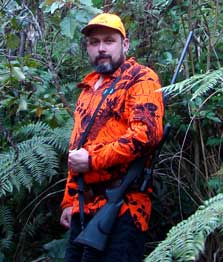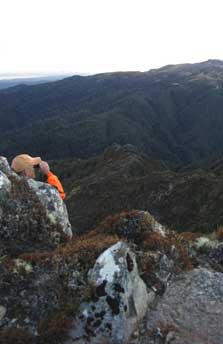
Wise hunters wear high visibility gear
This basic gear list is a great start when planning a hunting trip.
Pack and sleeping
- Pack & pack liner
- Tent or tent fly and ground sheet
- Bed roll or inflatable mattress
- Sleeping bag
Clothing
- 2 x wool or polypropylene tops
- 2 x wool or polypropylene long johns
- 2 x pair shorts
- 2 x pair of socks
- 2 x pair of underpants
- Warm jersey
- Waterproof jacket
- Sturdy boots
- Gaiters
- Warm hat
- Gloves
- Over trousers
- Spare camp footwear
What colour to wear?
It is recommended that hunters should wear clothing that contrasts with the environment they are hunting in, as there is no evidence that suggests deer can or cannot see any one colour better than another (New Zealand Police, 2003). Deer will spot a hunters movement rather than the colour of their clothing.

Hunter with binoculars
Toiletries
- Soap, toothbrush & toothpaste
- Small towel
- Toilet paper
- Visit the Kiwi way – never miss an opportunity to use a loo and be prepared with a back-up toilet option
Food, drink & snacks
- High energy food & snacks
- Water bottle(s)
- Cooking stove and fuel
- Billy/fry pan
- Plate, cup and cutlery
- Dishwashing liquid and dish cloth
Hunting and navigation
- Map and compass
- Skinning knife
- Rifle and sling
- Ammunition
- Rifle cleaning kit
- Mesh bag(s) for hanging meat
- Small shovel
- Hunting permit
- Personal locator beacon (PLB). Find out more about PLBs
- Torch or head light
- Binoculars (optional)
- GPS (optional)
Safety and personal
- Personal first aid kit
- Survival kit
- Camera
- Spare batteries
Source: doc.govt
Comments
Post a Comment